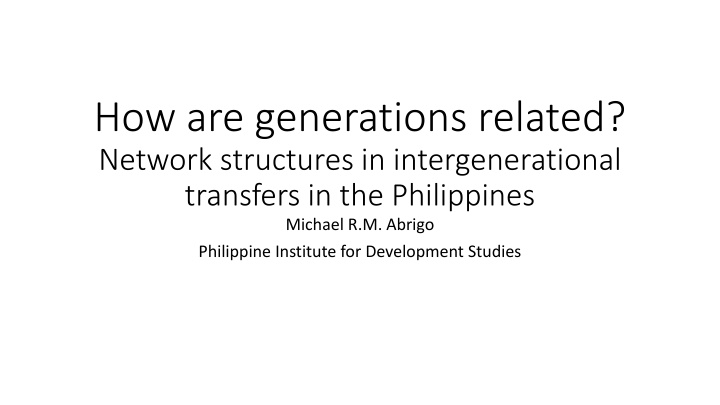
Generational Links and Transfer Patterns in the Philippines
Explore network structures in intergenerational transfers in the Philippines and how generations are linked through transfer systems. Discover the significance of transfers for consumption financing, the dominance of private transfers, and the direction and wealth dynamics of transfers between different age groups.
Download Presentation

Please find below an Image/Link to download the presentation.
The content on the website is provided AS IS for your information and personal use only. It may not be sold, licensed, or shared on other websites without obtaining consent from the author. If you encounter any issues during the download, it is possible that the publisher has removed the file from their server.
You are allowed to download the files provided on this website for personal or commercial use, subject to the condition that they are used lawfully. All files are the property of their respective owners.
The content on the website is provided AS IS for your information and personal use only. It may not be sold, licensed, or shared on other websites without obtaining consent from the author.
E N D
Presentation Transcript
How are generations related? Network structures in intergenerational transfers in the Philippines Michael R.M. Abrigo Philippine Institute for Development Studies
Transfer systems are important Important source to finance consumption With strong regional patterns (Lee and Donehower 2011) In East Asia and the Pacific, as much as 88% for children (Taiwan 2010) and 61% for the elderly (China 2007) In South and Southeast Asia, as much as 90% for children (Thailand 2011) and 22% for the elderly (Cambodia 2009) Link different generations without explicit quid pro quo arrangement
Much of what we know about transfers are based on how much generations receive from or provide to other cohorts in the economy
Transfers per capita in the Philippines Per capita transfers in the Philippines, 1990- 2015 C Consumption TF[I/0] Private Transfers TG[I/0] Public Transfers
Transfers per capita in the Philippines Private transfers dominate Philippine transfer systems Children rely substantially on transfers; the elderly less so Elderly from net giver to net receiver of transfers
Transfer direction and wealth What is the average of transfer inflows and outflows (direction)? How much does an average person expect to receive (wealth)? Mean Age TF TFI/C (in %) Mean Age TG TGI/C (in %) Inflow Outflow Inflow Outflow 1990 1995 2000 2005 2010 2015 45.3 44.4 43.0 42.9 45.7 47.4 50.5 51.8 51.0 50.7 50.3 50.3 74.3 72.8 60.9 62.9 76.7 73.1 44.4 45.6 49.1 50.3 46.9 47.2 49.7 52.4 52.2 53.5 53.7 55.1 14.5 16.2 18.8 15.0 14.7 15.7
Transfer direction and wealth In the Philippines, transfers are generally downwards from older to younger generations; Diverging pattern in gap between TG and TF Mean Age TF TFI/C (in %) Mean Age TG TGI/C (in %) Inflow Outflow Inflow Outflow 1990 1995 2000 2005 2010 2015 45.3 44.4 43.0 42.9 45.7 47.4 50.5 51.8 51.0 50.7 50.3 50.3 74.3 72.8 60.9 62.9 76.7 73.1 44.4 45.6 49.1 50.3 46.9 47.2 49.7 52.4 52.2 53.5 53.7 55.1 14.5 16.2 18.8 15.0 14.7 15.7
Transfer direction and wealth Transfer (inflows) are as much as 80-90% of consumption; Transfer wealth about 8-10 times of consumption Mean Age TF TFI/C (in %) Mean Age TG TGI/C (in %) Inflow Outflow Inflow Outflow 1990 1995 2000 2005 2010 2015 45.3 44.4 43.0 42.9 45.7 47.4 50.5 51.8 51.0 50.7 50.3 50.3 74.3 72.8 60.9 62.9 76.7 73.1 44.4 45.6 49.1 50.3 46.9 47.2 49.7 52.4 52.2 53.5 53.7 55.1 14.5 16.2 18.8 15.0 14.7 15.7
We know that transfer systems are much more complicated because transfers are not (usually) anonymous (especially for private transfers)
Intergenerational Transfers Matrix Philippine Public and Private Transfer Matrix 1990 Public Transfers (TG) Private Transfers (TF)
Intergenerational Transfers Matrix Philippine Public and Private Transfer Matrix 2000 Public Transfers (TG) Private Transfers (TF)
Intergenerational Transfers Matrix Philippine Public and Private Transfer Matrix 2015 Public Transfers (TG) Private Transfers (TF)
Network structure in Transfer Systems Private Transfers 2015 Different generations are intimately linked through transfer systems Changing importance as generations course through economic lifecycle Changing network structure based on different factors: demographic change, public policy, etc.
Network structure in Transfer Systems Private Transfers 2015 How do we summarize network structures? In this presentation, we look at two measures Spatial dependence: Are transfers to/from proximal generations correlated? Network centrality: Which generation/age group is more important in the network?
Spatial dependence 1.0 Borrowed from spatial statistics, Moran s I, to measure spatial autocorrelation Strong spatial dependence for both public and private transfers across years; Only slightly higher for TG Suggests clustering in intergenerational flows (Global spatial autocorrelation) 0.8 Moran's I 0.6 0.4 0.2 Private Public 0.0 1990 1995 2000 2005 2010 2015 Year
Network centrality Transfer systems are special Directed transfers (inflows v. outflows) Links are weighted (by amount of flow) Many nodes as there are generations May be expanded by other classes and linkages Limits what measures may be used Eigencentrality: measure the influence of a node (generation or age group) in the network (transfer system). Those linked to more important generations, i.e., more central, are assigned higher weights
Network centrality Young adults are generally more important (central) in the Philippine transfer system but apparent shift in centrality towards older cohorts 1.0 1.0 Private Transfers (TF) Public Transfers (TG) 0.8 0.8 Eigencentrality Eigencentrality 0.6 0.6 0.4 0.4 0.2 0.2 0.0 0.0 0 20 40 60 80 0 20 40 60 80 Age group Age group 1990 1995 2000 2005 2010 2015 1990 1995 2000 2005 2010 2015
Summary and Next Steps Transfer systems as not (usually) anonymous New insights from analysis of intergenerational transfer matrices Some questions for the future What other network structures may be extracted from NTA data? Based on these measures, are there commonalities and differences across different countries or regions? How will the network structure/transfer systems expected to change with demographic and/or policy changes? How can these network structures be leveraged to expand consumption/deliver goods and services?

